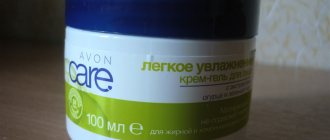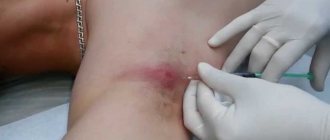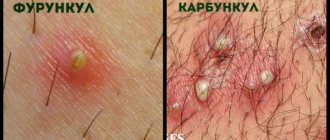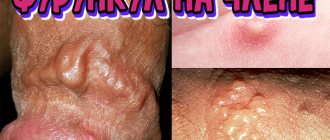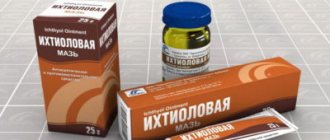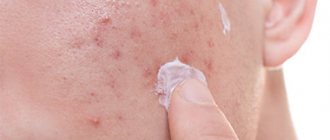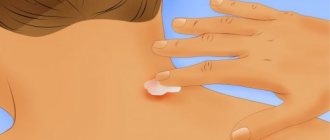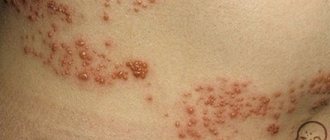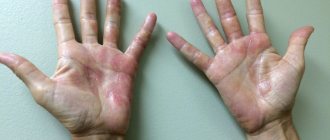You can distinguish a boil - an abscess resulting from an infection in the hair follicle - on your own. At an early stage of development it is easy to eliminate. When the condition is neglected, furunculosis appears. The disease is accompanied by inflammation of the hair follicles with the presence of pus, provoked by Staphylococcus aureus. Once in the fatty layer under the skin, inflammation of the follicle occurs. Boils continue to spread to areas of the skin, and a chronic form occurs.
What is furunculosis?
Furunculosis is a pathological process that manifests itself in the form of purulent-necrotic inflammation of the hair follicles, which are called follicles. The main causative agent of this disease is Staphylococcus aureus. When Staphylococcus aureus enters the subcutaneous fat layers, it begins to provoke inflammation, as well as tissue necrosis. If boils periodically form on various parts of the body over a long period, then it is customary to talk about chronic furunculosis. To avoid any complications, you need to know how to distinguish a boil from a pimple.
What is the danger of this disease?
The main danger of this disease is the potential development of life-threatening complications. Thus, boils located in the area of the nasolabial triangle should be under close medical attention.
The blood supply in this area has such characteristics that infection through the blood vessels can easily penetrate into the area of the orbit and skull, causing the development of intracerebral and orbital complications. When boils are located near the lymph nodes, patients often experience lymphadenitis and lymphangitis.
Decreased immunity and illiterate treatment of the disease can lead to generalization of the infectious process and the development of sepsis (blood poisoning).
Reasons for appearance
If one boil has formed on the body, this does not mean that the person has contracted furunculosis. However, if the patient is not attentive to treatment, then this neoplasm can cause the appearance of new pustules on the body. The main reason for the formation of boils is the entry of bacterial flora, mainly staphylococcal, into damaged areas on the body. In addition, some unfavorable factors can contribute to the development of the disease, which include:
- various microtraumas on the skin of the face, such as scratches or scratches;
- failure to comply with hygiene standards;
- weakened immune system;
- age-related changes in the skin, for example adolescence among adolescents;
- hormonal imbalance in the body;
- poor nutrition;
- vitamin deficiency or hypovitaminosis;
- regular contamination of the epidermis of the skin;
- oily type of facial skin;
- excessive sweating.
In some cases, boils can form on the body due to hypothermia. Other reasons for the formation of these ulcers are:
- deficiency of vitamins in the body;
- emotional and physical fatigue;
- presence of chronic diseases;
- impaired metabolism in the body;
- scratching insect bites;
- inflammatory and infectious diseases.
Basically, boils form on the body in the spring, when people have weakened immunity, as a result of which one can easily catch any infection.
Provoking factors
Furunculosis may be present on the skin in the form of neoplasms in small quantities, however, under favorable conditions, Staphylococcus aureus can begin to actively multiply, provoking purulent processes on the body. Factors that contribute to the activation of Staphylococcus aureus:
- poor hygiene;
- hypothermia;
- viral diseases, such as influenza and acute respiratory viral infections;
- abrasions on the skin;
- imbalance in intestinal microflora;
- weakened immunity due to unfavorable environmental conditions;
- taking certain medications, such as antibiotics.
It should be noted that all factors that create favorable conditions for the proliferation of Staphylococcus aureus are in one way or another based on reduced immunity. For this reason, treatment of furunculosis must be comprehensive.
Symptoms of furunculosis
When talking about how to distinguish a boil from a pimple, you should familiarize yourself with the symptoms of furunculosis. Identifying a boil will not be difficult, since it is noticeable, and pain may be observed in the area of its formation. What is the difference between a pimple and a boil?
- the swelling of a boil will be much greater than that of a simple pimple;
- redness in the area of the boil is most extensive;
- the boil may be accompanied by itching;
- there is almost always a hair in the center of the boil, which cannot be said about a regular pimple;
- the boil is accompanied by pain.
A few days after the formation of the boil, the skin begins to thicken, acquiring a bright red tint. After some time, the swelling becomes greater, and the boil itself begins to pulsate, the pain increases. When considering how to distinguish a boil from a pimple, it is worth noting that at the stage of development of this abscess, its size in diameter can be up to 3 cm, which cannot be said about an ordinary pimple.
After some time, a purulent core, a small blister filled with pus, may form at the site of the boil. Considering how a pimple differs from a boil, the following symptoms of furunculosis should be highlighted:
- increased body temperature;
- severe fatigue;
- general weakness;
- headache;
- muscle pain;
- inflammation of the lymph nodes.
At the last stage of development of furunculosis, the abscess bursts and pus comes out of it, after which the wound begins to heal. The ripening time of a boil usually ranges from 7 to 12 days. In some cases, to treat boils, a laboratory test is required, for which pus is taken from the neoplasm. If more than 3 ulcers appear on the body, then it is necessary to donate blood to determine the level of inflammation.
Stages of development
Medical science suggests distinguishing several stages of the formation, ripening and healing of a boil:
- Infiltration. A hyperemic edematous infiltrate forms, accompanied by redness, tension and soreness of the affected area. There may be symptoms of intoxication - headache, aching joints.
- Suppuration. A purulent-necrotic core is formed, accompanied by elevated temperature and severe pain.
If neighboring areas of the skin are involved in the inflammatory process, then such a formation is called a carbuncle
- Aging. Spontaneous or surgical opening of a purulent formation occurs, accompanied by the release of purulent masses. The process is accompanied by an improvement in well-being and a decrease in pain.
- Scar formation. After removing the purulent mass (rod), a recess is observed in the soft tissues - a channel that previously contained a purulent rod. It is gradually filled with granulation tissue - scarring occurs.
The disease can progress in different ways, accompanied by a combination of certain stages, their accelerated or longer course - it all depends on the clinical condition of the patient and the presence of contributing factors.
How to distinguish a boil from a pimple
A photo of a boil and a pimple can clearly show the differences between these neoplasms. However, to be completely sure that it is a boil that has formed on the body, and not a simple pimple, one must be able to distinguish between the invisible symptoms of these neoplasms. First of all, you need to figure out how to distinguish a boil from a pimple (photo not shown for aesthetic reasons). In fact, outwardly you can see some similarities, so not everyone can immediately understand what exactly they are dealing with.
Speaking about how to understand whether a boil or pimple has formed on the face, it should be noted that there are differences in the nature of their formation. Regular acne on the body can appear for a variety of reasons, while boils are formed solely due to exposure to Staphylococcus aureus. The boil also has a rather deep internal root. For this reason, opening an abscess on your own can cause aggravation during the entire treatment.
When considering how to determine whether a boil or pimple has appeared on the face, you should pay attention to a solid formation that has an internal root that rises significantly above the abscess. Regular acne usually does not have a hard core. Another difference between a boil and a pimple is its bright red hue. This indicates the initial stage of development of furunculosis. It is worth paying attention to the fact that, unlike acne, boils on the body may not have clear boundaries, and the process of their formation sometimes occurs with severe pain.
How can you tell if a boil is starting to form under the skin?
When answering this question, you should pay attention to the clinical manifestations of boils. Speaking about how to distinguish a boil from a pimple at an early stage of its development, you should pay attention to the symptoms indicating that this is not a simple pimple on the body:
- a swelling forms on the skin, which is dense to the touch, while its center is raised;
- the skin becomes red in color, and the redness does not have clear boundaries;
- pain is observed not only during touching, but also as an independent symptom;
- the resulting tubercle may be accompanied by itching;
- every day the symptoms become more pronounced, and the swelling increases in size;
- a week later, pus from the boil begins to flow to the top of the neoplasm.
Treatment methods
When the first signs of acne formation, similar to boils, appear, iodine can be used as an antiseptic drug. The skin around the tumors is treated with chlorhexidine or simple alcohol. While suppuration is observed, ichthyol ointment, which resolves pimples and boils, can be used as an adjuvant. In addition, Levomekol is a very effective ointment against boils.
It is worth paying attention to the fact that when treating a boil, it is strictly forbidden to warm up the neoplasm.
Experts also do not recommend removing boils on the body yourself. When squeezing, there is a possibility of introducing some kind of infection into the resulting wound. Ultimately, the tumor will begin to increase in size, accompanied by severe pain. Therefore, you should not remove the abscess yourself, since the bacteria that are in it can penetrate deeper into the skin, and then into the blood.
Cases have been recorded where, due to the formation of one boil, internal organs were infected with staphylococci, which provoked serious consequences. Only a qualified dermatologist can correctly remove the tumor and make the appropriate medication selection. Boils, pimples with purulent contents on the face or other area of the body are a signal that you need to immediately visit a medical facility.
Features of dealing with the problem
Only a doctor can assess the condition and decide which treatment methods to use.
To quickly get rid of an abscess, it is recommended to consult a dermatologist. Only a doctor can assess the condition and decide which treatment methods to use. If the immune system functions normally, boils quickly mature and open. Under no circumstances should you try to squeeze out the formation, especially without maintaining hygiene and during the period of its maturation, when the rod is not yet fully formed. This way the pathogen can penetrate even deeper into the tissue, expanding the focus of inflammation.
The first step in fighting a boil is to speed up its maturation. For these purposes, a certain medication is used - ichthyol ointment or Vishnevsky balm. If there is hyperthermia, warming procedures cannot be carried out; if there is no temperature, such treatment can be carried out. Every few hours, lotions or applications must be changed.
After the abscess has matured, you should carefully remove its contents or wait until it drains out on its own. Then rinse the wound with hydrogen peroxide and apply a bandage with an antibacterial agent. This formation may leave a scar, so it is recommended to use anti-scar products. It is not allowed to apply foundation or powder to a ripening boil, as this may worsen the infectious process.
If the abscess is not a single one, but there are many of them on the surface of the skin, the measures described above will not be enough. Here you will need more serious treatment - the use of antibacterial drugs, immunostimulating therapy, purification of blood fluid. Sometimes the disease can drag on for a long time. Additionally, after the doctor's permission, you can use folk remedies - activated carbon, decoctions of medicinal plants.
Folk remedies
There are many different folk recipes with which you can overcome the symptoms of an unpleasant disease. To remove a boil at home, the following traditional medicines are often used:
- Burdock. To do this, you need to boil burdock leaves in milk, and then apply them to the affected areas on the body overnight.
- Aloe. Aloe leaves are a traditional remedy for the treatment of various purulent diseases of the skin, including the fight against furunculosis. However, it is worth paying attention to the fact that the medicinal properties of plants appear in the fourth year of their life. The juice contained in aloe leaves helps the pimple to mature, after which all the purulent masses are drawn out. To do this, you need to cut the leaf lengthwise and apply it to the affected areas on the body.
- Onion. Onion is another folk medicine that is capable of sucking out pus from tumors well. To do this, you first need to boil the onion head, then apply it to the affected area overnight, securing it well with gauze or another bandage.
- Rye flour and honey. These products must be mixed until a dough-like mass is obtained, after which the product is applied to the affected areas, bandaged well and left overnight.
- Laundry soap. To treat a boil, you need to grind the laundry soap and pour plain water for 15 minutes. Apply the thick mixture onto gauze and apply to the resulting boil. The bandage must be changed every three hours.
- Vishnevsky ointment and fir oil. This folk remedy is very effective for treating boils at home. A mixture of Vishnevsky ointment and fir oil has an excellent warming effect, which accelerates the maturation of the boil. To prepare the mixture, you need to mix 7 parts of fir oil with 3 parts of Vishnevsky ointment. This composition is also ideal for the treatment of internal simple acne. Fir oil has analgesic and antimicrobial properties, and Vishnevsky ointment helps cleanse inflamed skin of various bacteria, accelerating the maturation of the boil and further healing.
When treating boils and pimples with purulent contents at home using folk remedies, it is necessary to remember that such treatment methods can only be used at an early stage of the development of the disease. Otherwise, treatment of this disease should be carried out by a qualified specialist.
Opening a boil
In advanced forms, there is a need for surgical intervention to remove the boil. In this case, the neoplasms are opened, after which thick purulent contents are removed from them in small quantities. Purulent contents accumulate at the surface of the skin, resulting in the formation of a small ulcer, at the bottom of which there is a necrotic greenish core. This root should open within a few days, after which a small amount of blood and pus will come to the surface.
Diagnostics
The diagnosis is made based on visual examination and the clinical picture of the disease. A general urine test is taken and a bacteriological examination is carried out to determine the presence of the pathogen. For this analysis, purulent discharge from the boil is taken. The doctor may prescribe a consultation with other specialists, for example, an ENT doctor.
In chronic, severe forms of the disease, a more thorough medical examination is required.
The patient must undergo the following tests:
- general blood and urine analysis;
- blood chemistry;
- analysis for hepatitis B and C;
- HIV test;
- stool analysis;
- determination of hormone levels: sex and thyroid glands;
- ECG;
- X-ray of the chest and sinuses.
Forecast
If a boil appears on the face or other area of the body, this means that the patient has some kind of problem with the immune system. Such inflammatory formations can periodically appear on the body again and again. This indicates that there are some more serious disorders in the human body. In such cases, you need to seek help from a specialist so that he can prescribe a full examination to determine the provoking pathology.
To prevent the development of furunculosis, experts recommend carefully monitoring the health of your body. It is also necessary to adhere to the correct regime and diet, give up all existing bad habits, and also adhere to the simplest rules of hygiene.
Preventive actions
What is the difference between a boil and a boil? The answer is simple - it’s the same education. To prevent its occurrence, it is recommended to follow simple recommendations:
- adjust your diet, include a large amount of fresh fruits, vegetables, herbs, this will help strengthen your immune system;
- periodically take multivitamin complexes;
- promptly disinfect damaged areas of the skin - cuts, abrasions, bites, microcracks;
- if possible, avoid hypothermia and sitting on a cold surface;
- Do not treat yourself with antibacterial drugs, without the supervision of a specialist.
If you follow simple measures, you can prevent the appearance of boils.

